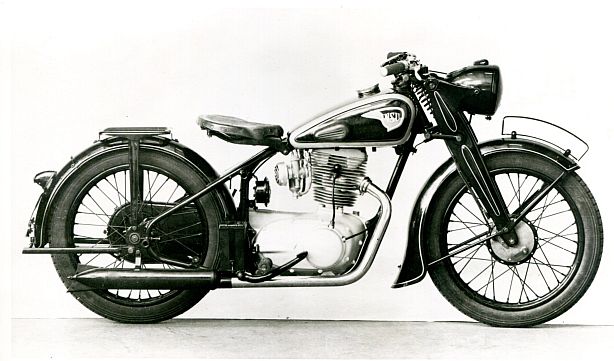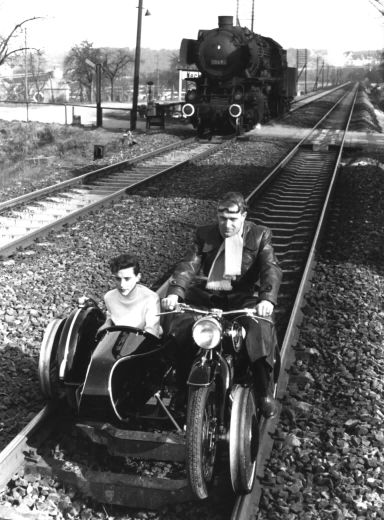|
|
The NSU-MAX model family |
A picture tells more than thousand words, as we say in Germany. So we show you here pictures of the various types of the NSU MAX model family.
These small pictures are for preview. Click on the picture to get the picture in better resolution.
Is hardly known that there was already before the end of the Second World War a NSU motorcycle with the label 251 OSB
 NSU 251 OSB 1940 |
The 251 OSB was developed in the wake of the Nazi
standardization efforts in vehicle (Schell-Plan) to have a 250 cc
motorcycle in the program. Apart from the 251 OSL was getting old and their
structure with separate gearbox it was expensive to produce. There some test samples were as far completed, that they could go to the driving test, but the 251 OSB came not in mass production. |
|
NSU 251 OSL 1952 |
Predecessor of the MAX was the NSU 251 OSL from the successful OSL series.
|
|
In late 1952 the MAX was ready for sale. It was a hit. Roaring 17 hp (13 kW)
from only 250 ccm capacity were a lot of power, especially in a reliable motorbike for
everybody, not in a pure sports bike. |
| In 1954 came the SPEZIALMAX with the bigger "buffalo style" fuel
tank, containing 14 litres and with big aluminium alloy brake drums, which provided much
better brake performance. These changes SPEZIALMAX acts considerably beefier than the relatively petite STANDARDMAX, although the frame, fork, wheels and fenders are identical of its dimensions. |
| In late 1956 came the SUPERMAX. Everybody could recognize her by the two external springs/dampers at the rear suspension. (The earlier STANDARD- and SPEZIALMAX had one single rear spring and damper inside the frame like modern motorbikes) But if you look on the details, nearly each part of the SUPERMAX is a little bit different from those of the STANDARD- or SPEZIALMAX. This makes SUPERMAX parts hard to get... |
These were the standard models of the MAX, which could buy anyone at NSU dealer of their choice. In addition to these models for everyone but there were also the famous competition models and some special versions for export.
|
In 1954 offered the American
importer Butler & Smith on a sporty off-road motorcycle on Max-base.
The Max TT was a true Geländemax early style, so on the Standardmax
based with central suspension and sheet-rear. The engines may have
done so to 21 hp .
Allegedly some 40 pieces were made. The image belongs to the online encyclopedia Wikipedia. |
|
In 1957, at the special request of
the American importer, a series of 230 special motorcycles for in
America at that time quite popular "Scramble" events, a mixture
between motocross and off-road competition. Designed from the
Gelände-Max
were the most striking features: Outboard front dampers on extended fork; 21 " -front-wheel; small apron; smaller, easy to take off with electric connector lamp; MAXI-tank ; terrain handlebars; high-mounted footrests; high-mounted exhaust; seat; big tail light (like BMW R27 ) is attached to the shortened rear mudguard; suspension like at Supermax. The engine corresponded to the normal Supermax series, so had 18 hp, but could be increased performance by installing a racing kit. The supplied silencer corresponded to the desire of the American importer for "strong exhaust sound", but resulted in loss of power. 12 machines were delivered to Yugoslavia, in Germany the MAX - Scrambler was not officially sold. (from: Stephan Thum, NSU Max 1952 - 1962, alle Ausführungen) |
In addition to serial and export models of the MAX, it was for authorities certain machines that were not delivered to private customers:
Leichtes Funkkraftrad NSU-Supermax |
SUPERMAX with radio equipment. This is located in the two large boxes. Increased battery was in one of the boxes in front of it - they are originally from the OSL series - housed. The speaker/microphone combination is mounted on a support bar on the handlebar. Next to it is the blue light. How many machines were built is unknown. |
| First choice for off-road racing, especially with sidecar, was the
GELÄNDEMAX: The GELÄNDEMAX was a competition bike, which won the German championship for off-road racing in the 250 cc class from 1955 to 1960. Early GELÄNDEMAXes had a 21" front wheel and a longer front fork. Later models had a 19" front wheel and external shock dampers at the front fork. |
The engine was tuned and offered a performance somewhere between 19 and 25 german DIN hp.
More features of the GELÄNDEMAX were:
There were only a few "real" GELÄNDEMAXes, which were built by the research
department of NSU and there were much more "replica" GELÄNDEMAXes, which were
built by the off-road drivers, using more or less original NSU GELÄNDEMAX spare parts.
The NSU Advertising Department at Arthur Westrup
sent every year end of March to all them known newspaper and magazine editors a
photo with a press release for publication on the first of April. The picture
then a NSU model was seen in a very special design and the text gave the
relevant explanations. Often this was so trustworthy written, that the
responsible editor did not realize that them wanted to send him and his readers
in April.
Whether
commented accordingly or not, image and text were published, NSU was on
everyone's lips, and that was the main thing.
Relatively well-known is the picture of a Max-sidecar
combination, which was mutated to rail vehicle. The photo was taken near the
Neckarsulm station. It is not known whether the construction was actually
drivable on rails.

last update: 26.10.22